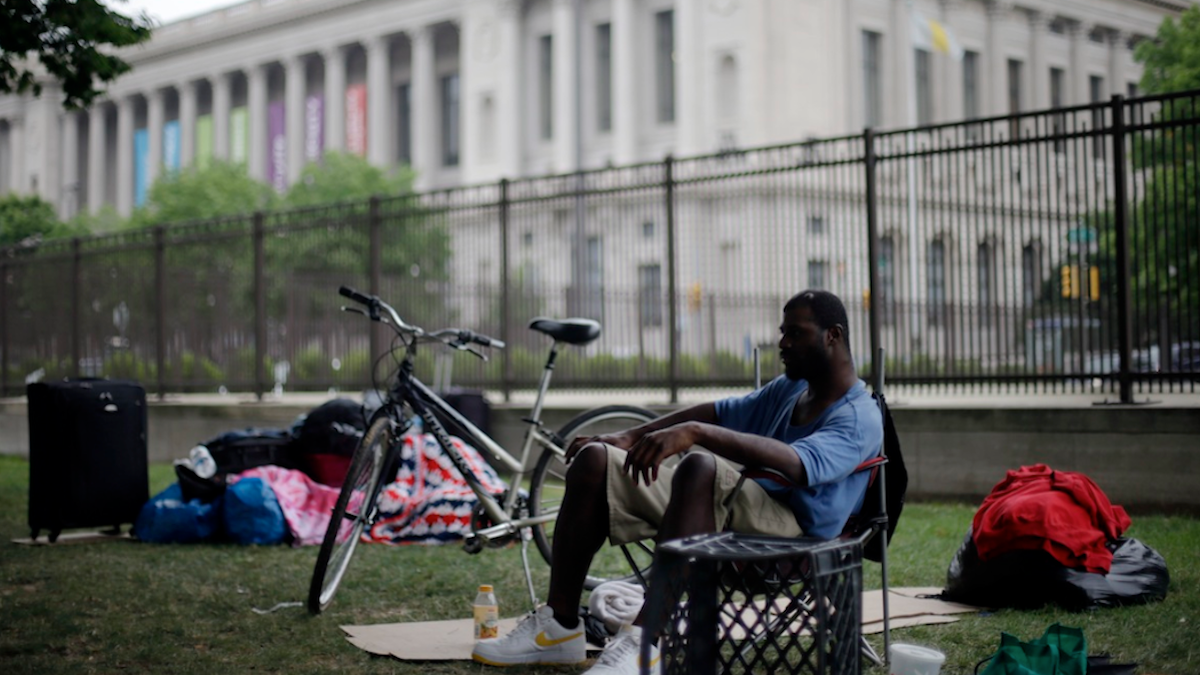How a poverty study speaks to all races in Philadelphia

Terrell Caldwell, who has been homeless for four years, sits among his possessions in view of the Free Library of Philadelphia where Mayor Michael Nutter announced an anti-poverty plan called "Shared Prosperity Philadelphia" earlier this month. (AP Photo/Matt Rourke)
I thought of Philadelphia when I learned of an exclusive Associated Press survey revealing that 4 out of 5 American adults struggle with near-poverty, unemployment or rely on government assistance for at least part of their lives.
The numbers were based on an analysis of U.S. Census Bureau and Population Reference Bureau data by Mark Rank, a professor at Washington University in St. Louis.
Among the major findings
For the first time since 1975, the number of white female-headed households living in poverty with children surpassed or equaled black ones in the past decade, spurred by job losses and faster rates of out-of-wedlock births among whites.
Since 2000, the poverty rate among working-class whites has grown faster than among working-class non-whites.
And, non-Hispanic whites accounted for 17 percent of the child population in neighborhoods with poverty rates of 30 percent or more.
As the major findings show, the AP survey’s data was presented in way that focused heavily on race. But that’s not a bad thing when it comes to poverty. Why? Because poverty is too often seen as something that only affects minorities.
Until that message changes, plans to address poverty will continue to generate the kind of us-versus-them demagoguery that allows income inequality to grow.
Prime example: Philadelphia
Here, in a city with a 28.4 percent poverty rate, plans to address poverty have formed too slowly and have often appeared to be more fluff than substance.
Could this be because Philadelphia’s poverty is concentrated in black communities in North and West Philadelphia? I can’t say with certainty, and the answer is beside the point.
The point — if we are to be honest about this city’s poverty — is that Philadelphia’s income inequality has deep historical roots that are heavily influenced by racial dynamics. We must acknowledge that in order to effectively address the problem.
For example, we should know that government policies like urban renewal and school segregation, labor policies that largely excluded minorities from some labor unions, and bank policies such as redlining helped to proliferate poverty in Philadelphia’s minority communities.
Why is that important? Because such policies have generational consequences that continue to sustain poverty.
Personal responsibility
Make no mistake: Individuals play a role in their own fates. But for generations of black Philadelphians, that individual responsibility included finding ways to overcome systemic barriers that kept blacks excluded from certain professions, neighborhoods, schools and opportunities.
Any examination of poverty in our city must include those realities, but while a new City initiative and various studies have been well meaning, most failed to acknowledge or address conditions that brought us to this point.
Yes, it is true that Philadelphia’s loss of manufacturing was an economic body blow that led to a mass exodus of citizens and an erosion of our tax base.
Yes, it is true that job creation is more difficult in Philadelphia because our small-business tax structure is borderline ludicrous.
However, those are not the only factors that earned Philadelphia the top poverty rate among large American cities.
There is also the fact that generations of Philadelphians were pushed into pockets of poverty by a combination of economic forces and government policy, including a segregated school system that required judicial intervention to change.
Thus, when citizens — including middle-class blacks — had the opportunity to leave Philadelphia, they did so. The loss of 600,000 residents since 1950 meant that many of those who remained were the ones too poor to move.
We’re not outliers
That Philadelphia dynamic is not unique. Rather, it is illustrative of a larger national issue that seems to have been glossed over in the AP analysis of the data.
While it is troubling that working-class whites have experienced a rise in poverty of 3 percentage points, moving their overall poverty percentage to 11 percent, poverty among non-whites is 23 percent —more than double the rate among whites.
That continuing disparity can be traced to the systemic conditions faced by generations of minorities not only in Philadelphia, but also in cities around the country.
However, there is a silver lining to the proverbial cloud that is America’s poverty.
Calling for a united front
The AP data, which focuses on the plight of the white working class, shows that poverty is no longer an us-versus-them proposition. It is now simply about us — all of us.
If we are to address poverty in America, it is incumbent upon every American to look beyond the most recent recession and recovery.
We must also take a sober look at the conditions that created and sustained large pockets of poverty in big cities like Philadelphia and in vast rural areas such as Appalachia. Then, we must do everything we can to make sure we do not allow those conditions to return.
That means our children must receive equal educations that will allow them to compete on a global stage.
It means we must create the kinds of jobs that allow Americans to earn a living wage.
It means we must have the kind of tax structure that allows small businesses to thrive.
It means we must stop spending our energy trying to hold back certain segments of our population.
Only then can we truly address poverty in our country. Anything less than that is just lip service.
WHYY is your source for fact-based, in-depth journalism and information. As a nonprofit organization, we rely on financial support from readers like you. Please give today.

